DENTAL IMPLANTS FROM A-Z
The Solution To Replace Missing Teeth
Get Dental Implants!!
Ft Lauderdale/ Broward County
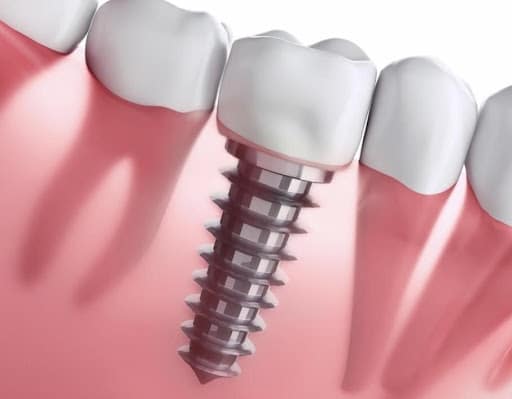
Why Choose Dr. Sultan for your Implant Treatment?
Are you looking for permanent tooth replacement using dental implants in Ft Lauderdale or Broward County? Are you seeking a board-certified oral & maxillofacial surgeon with advanced training in ALL areas of implants, bone grafting, and jaw reconstruction?
At the Sultan Center for Oral Facial Surgery, Dr. Leslie Sultan has been providing advanced dental/zygoma implant care since 1990!
Dr. Sultan was one of the first US practices to become a ZAGA Zygoma International Center of Excellence. This exclusive group of surgeons across the globe strives to maintain the most innovative and effective treatments for patients with severe bone loss through training and research.
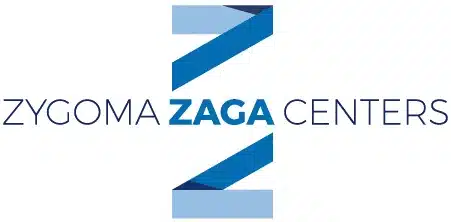
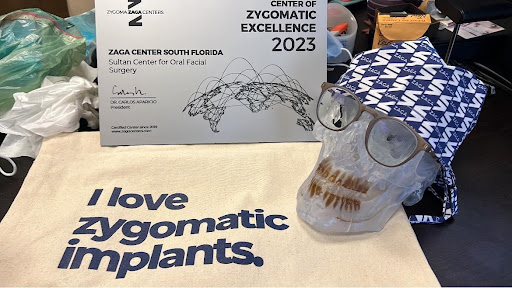
Dr. Sultan is a faculty member of the internationally renowned PIKOS INSTITUTE, assisting in the education of other dentists and surgeons in the placement of advanced ZYGOMATIC and PTERYGOID implants.
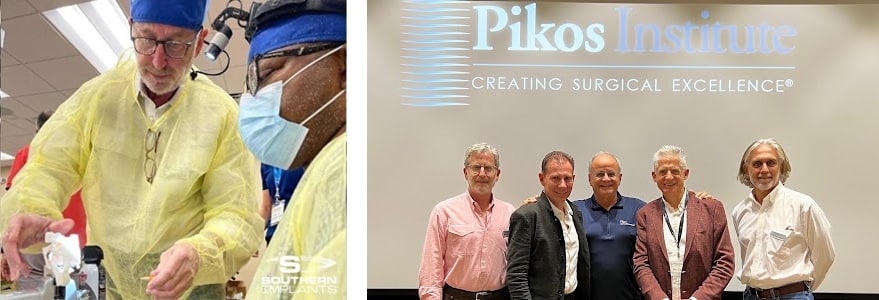
Dr. Sultan advances his education and training by attending multiple continuing education seminars and courses both nationally and internationally to advance his knowledge of the latest techniques in the specialty.
What People Say About Us!
Tremendous Experience Few Others Could Deliver, I couldn't be happier with the work of Dr. Sultan or more eager to recommend his services to those in need. Not only is his knowledge and experience in a class of its own but his ability to maximize results and comfort is second to none, particularly in cases that are difficult with few available alternatives. In my case, he was the only known surgeon capable of performing this service and had other dentists raving about the results. I definitely recommend his services.
Click here to read more reviews.
Dial 954.771.8772 to reach our Fort Lauderdale office, and our staff will help you set up your dental implant consultation.
At the Sultan Center of Oral Facial Surgery in Fort Lauderdale, FL, Dr. Sultan and his staff provide state-of-the-art technology in the areas of:
- Dental Implants
- ZYGOMA and other REMOTE ANCHORAGE implants
- ALL-ON-4 / ALL ON X/ Teeth in A Day
- JAW IN A DAY
- Combined extraction / immediate implant placement
- Cone Beam CT (CBCT) in office / most advanced state-of-the-art scanner
- Computer-guided surgery for the most accurate implant placement
- Bone grafting and bone regeneration
- GROWTH FACTOR/STEM CELL regenerative technology
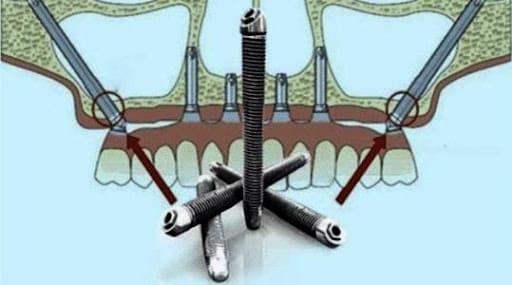
What Are Dental Implants?
Dental implants are tooth root replacements made from titanium which are inserted into the jawbone, providing a foundation for replacement teeth that look, feel, and function like natural teeth. Once a dental implant is surgically placed into the jawbone, the bone bonds with the titanium, creating a strong foundation for artificial teeth. After a period of healing (Osseointegration), small attachments (abutments) are then screwed to the implant. These protrude through the gums, providing the foundation for the placement of replacement teeth, bridges, or dentures.
Dental implants can replace a single tooth, multiple teeth, or a complete arch. They can provide support for a removable denture or a fixed (non-removable) bridge. A custom prosthesis (appliance) can replace not only teeth but supporting bone and soft tissue.
Dental implants, for example, with the "All-On-X" technique in Ft. Lauderdale, FL, or any other technique, help preserve facial structure, preventing the bone deterioration that occurs when teeth are missing. Patients who have lost teeth regain the ability to eat virtually anything, knowing that teeth appear natural and that they can smile with confidence. So it's no wonder that more and more patients are turning to dental implants as a better alternative to dentures and dental bridges. Studies have shown that the long-term success rates for dental implants exceed those for root canals, crowns, and bridges.
In fact, dentists and insurance companies have both agreed that the placement of a dental implant is now the standard of care for the replacement of a tooth.
The Traditional Approach to Dental Implants
The traditional approach for the placement of dental implants involves two stages. The first surgical phase involves placing the implants in the jawbone. For the first 2 to 6 months following surgery (depending upon each individual situation), the implants are beneath the surface of the gums, gradually bonding with the jawbone. You should be able to wear a temporary tooth replacement and eat a soft diet during this time.
After the healing phase, the second phase begins. Dr. Sultan will uncover the implants and then refer you back to your restorative dentist to place the final restoration on top of the implants. The average treatment time is 3 to 6 months. Should special bone or soft tissue grafting be required, treatment time may be longer. Most patients experience minimal disruption in their daily life.
The Immediate Approach to Dental Implants
For specific situations and techniques, implant placement and restoration can be performed together. The decision to “immediately load” an implant is based on a number of factors. The types of procedures that can be considered for immediate load protocol are:
- ALL-ON-4, ALL-ON-X
- ZYGOMA, REMOTE ANCHORAGE IMPLANTS
- Single implant (anterior only)
In all cases, only the temporary, or provisional restoration is placed initially to allow proper healing.
Candidates for Dental Implants
The majority of patients with missing teeth can successfully undergo implant placement. Those patients that have decreased resistance to healing/infection, or medical conditions complicating anesthesia, for example, should discuss these issues in detail with their physician and Dr. Sultan at the consultation.
Patients with specific medical conditions require specialized evaluation and consideration:
- Immunocompromise (Diabetes)
- Bleeding disorders
- Irradiated bone
- Patients on medication for Osteoporosis
- Smoking
- Bruxism
Overall, the average long-term (20-30 years) success rate for dental implants exceeds 90%! Of course, the success rate varies according to each individual patient and the procedure performed.
Remember, long-term success depends on a number of factors, including:
- Optimal treatment planning
- Surgical technique
- Final restorations
- Patient oral hygiene
- Patient medical condition
The primary goal in the dental implant treatment process is the placement of a final restoration (tooth, bridge, denture) in a position that looks as natural as possible. In order to facilitate this process, Dr. Sultan works as a team with your restorative dentist throughout all phases of treatment. A Cone Beam CT scan is necessary to evaluate bony anatomy and density throughout all phases of treatment and is required not only for an initial consult but part for long-term maintenance.
Reconstructing the Edentulous Arch
The "All-On-X Concept"
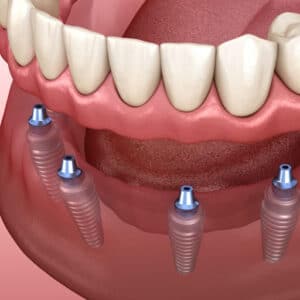
For those patients who have lost, or who are planning to lose all the teeth in their upper/lower jaws have limited options for restoration. The basic options are:
- Conventional removable denture
- Implant-supported removable overdenture
- Fixed, screw-retained hybrid/ bridge
Traditionally, treatment would involve a staged approach, beginning with tooth removal, bone recontouring, bone grafting, and implant placement followed by the final prosthesis. During this time period, sometimes lasting up to 2 years, patients are forced to wear a removable denture, or no teeth at all. Many patients become extremely frustrated during this process.
Fortunately, the ALL-ON-4 concept was developed to offer a more direct approach to restoring function and esthetics within a very short window (usually within 24 hours).
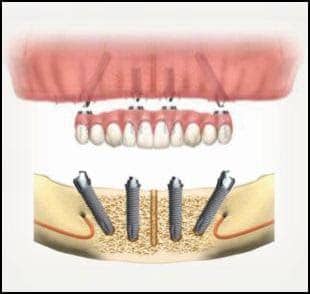
Traditional "All on 4" upper/lower
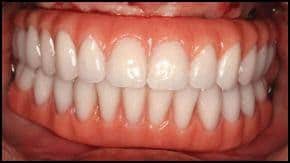
All on 4 Provisional upper/lower
With the "All-On-X" technique in Ft. Lauderdale, FL, or other similar techniques, help preserve facial structure, preventing the bone deterioration that occurs when teeth are missing. Patients who have lost teeth regain the ability to eat virtually anything, knowing that teeth appear natural and that they can smile with confidence. So it's no wonder that more and more patients are turning to dental implants as a better alternative to dentures and dental bridges. Studies have shown that the long-term success rates for dental implants exceed those for root canals, crowns, and bridges.
The principles of ALL-ON-X technique are based on a biomechanical design using angled implants strategically placed to maximize the usage of available bone and avoid extensive bone grafting.
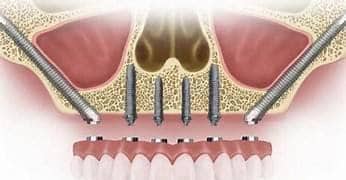
"Combo" All on 6 configuration
Zygoma, Transnasal, Transpalatal
Most importantly, taking advantage of the concept of "cross arch stabilization", the implants can be loaded, usually within the first 24 hours of placement, allowing patients to return to an improved quality of life in a much shorter period of time.
Typically, patients will first wear a provisional, or temporary appliance (fixed to the implants) for the first 3-6 months followed by the final appliance afterward.
Although the original technique called for the placement of 4 implants (All-on-4), additional implants (usually 4-6) are placed according to specific patient needs (All-On-X). This allows greater force distribution and load.
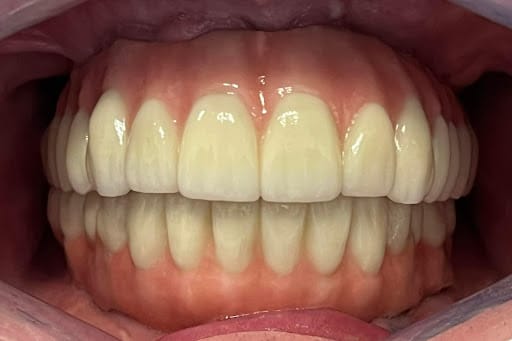
Final full arch Zirconia Prostheses upper/lower
Zygoma Implants & Remote Anchorage Techniques
The Solution to Treat Severe Bone Atrophy
"No Bone No Problem"
Whether the upper or lower jaw, severe bone loss can limit the use of the standard All-on-X technique.
Severe bone loss can occur from a number of conditions, including:
- Early tooth loss and long-term denture use
- Severe periodontal disease
- Denture mobility
- Chronic infection or trauma
- Cysts/tumors of the jawbones
- Congenital jaw deformities
- Previous/multiple failed implant surgeries
In these situations, advanced techniques can be utilized to overcome the obvious bone loss without compromising successful long-term outcomes.
Reconstructing the Bony Deficient Upper Jaw

The upper jaw is divided into 3 zones based on the type of tooth loss. When there is insufficient bone in one or more zones, conventional "ALL ON 4" implant placement may not be enough to support a full complement of tooth replacement.
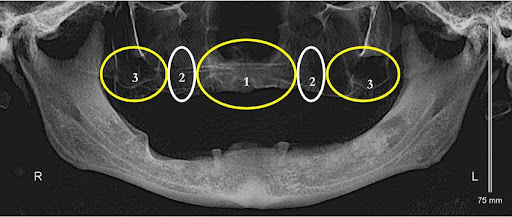
Zones of Implant Placement
Dr. Sultan may then recommend the placement of ZYGOMA implants to provide additional support where conventional implants cannot.
Originally designed for patients suffering from bone loss due to cancer or trauma, the ZYGOMA implant is indicated to make use of available bone in the CHEEKBONE to avoid the use of extensive bone grafting for conventional implant placement.
Embryologically, the ZYGOMA bone is one of the strongest in the facial skeleton and allows for great support for these implants.
These implants are made of titanium and are 4-5 times the length of conventional dental implants. Once placed, they act and are restored similarly to conventional length implants.
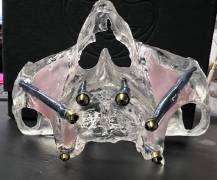
"Combo" All On X
Zygoma, transpalatal, pterygoid
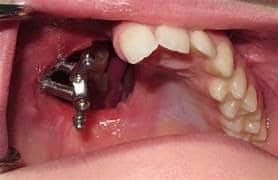
Zygoma implants to restore cancer defect
Zygoma Implant Technique
Proper planning, both medical and surgical, is essential for a successful outcome when placing zygoma implants.
- Patients with a history of sinus disease/smoking must be managed prior to implant placement.
- Computer-guided surgery and use of surgical models must be utilized.
- Due to the more extensive soft tissue dissection involved, at minimum deep sedation is recommended.
- Close coordination and planning with the prosthodontist and laboratory technician is essential.
The traditional placement of zygoma implants called for placement completely within the maxillary sinus. This resulted in long-term sinus complications and the emergence of the implants onto the palate.
Dr. Sultan utilizes the ZAGA concept for ZYGOMA implant placement, using the anatomy of the maxillary wall and extra-sinus implant placement where possible to avoid these issues.
Dr. Sultan was one of the first US practices to become a ZAGA Zygoma International Center of Excellence. This exclusive group of surgeons across the globe strives to maintain the most innovative and effective treatments for patients with severe bone loss through training and research.
Dr. Sultan is a faculty member of the internationally renowned PIKOS INSTITUTE, assisting in the education of other dentists and surgeons in the placement of advanced ZYGOMATIC and PTERYGOID implants.
For cases requiring ZYGOMA implants, either one or two implants are placed on each side. The majority of patients have (2) zygoma implants placed in combination with other types of conventional fixtures. Only a small percentage of patients with extensive bone loss require placement of (2) ZYGOMA implants on each side. This is known as the QUAD ZYGOMA configuration. When placed correctly, the implant positions are similar to those of conventional implant placement and can be restored in a similar manner. A provisional prosthesis can be placed the same day as surgery with the final prosthesis 4-6 months later.
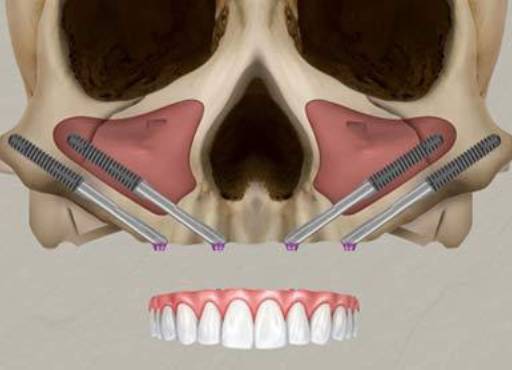
Quad Zygoma
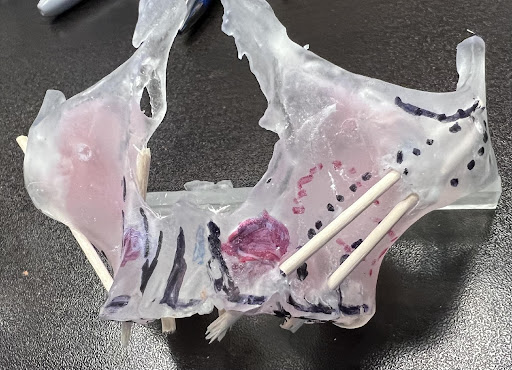
3D Model planning for Quad Zygoma
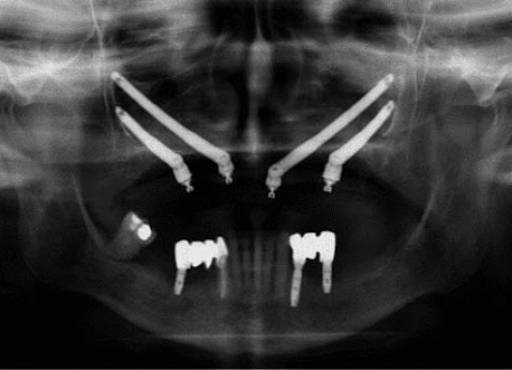
Quad Zygoma postop
Use of Other Remote Anchorage Implants
In a small percentage of patients, even the zygomatic bone may not have sufficient size, volume, or density to support an implant. Evidence-based studies have developed innovative implant solutions to take advantage of previously overlooked available bone sites in the upper jaw:
- PTERYGOID implants sit at the most posterior/inferior portion of the upper jaw
- TRANSNASAL/TRANSPALATAL implants are placed along the lateral portion of the nasal cavity
- SHORT WIDE DIAMETER implants can be placed in sites where previously sinus lift grafting would be done
- 3D PRINTED PATIENT SPECIFIC Implants form an overlay over areas of available bone to replace conventional implants (pending FDA approval).
These unconventional implants are used in combination with conventional and Zygoma implants to form a solid platform for a stable fixed prosthesis.
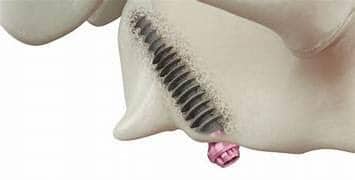
Pterygoid Implant
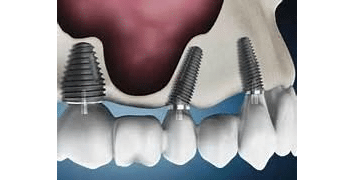
Wide Body Implant
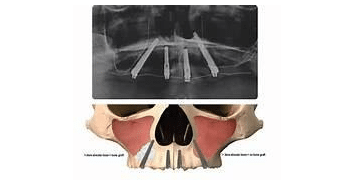
Trans-nasal Implant
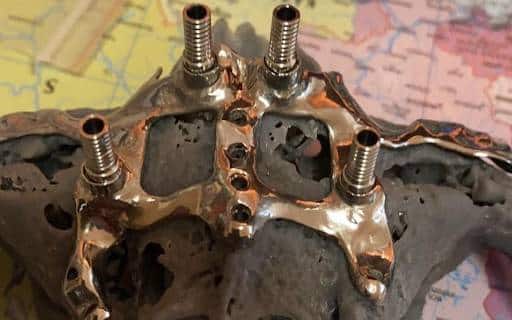
3D Printed custom Implant
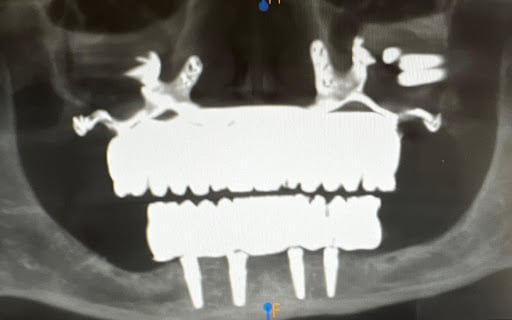
Postop 3D implant
Treatment Options for the Lower Jaw
In cases of mild to moderate bone loss, 4-5 implants using the ALL-ON-X protocol can be successfully placed without the risk of damaging the main sensory nerve to the lower jaw. If there is sufficient bone available, more posterior support can be added using the wider diameter, short implants. However, for cases of severe bone loss of the lower jaw, either a subperiosteal or 3D-printed custom implants are the preferred method of reconstruction in lieu of extensive bone grafting.
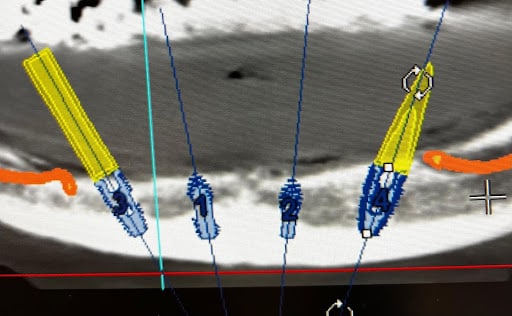
Virtual planning atrophic mandible
Jaw in a Day
In the past, patients committed to having a portion of the lower or upper jaw removed due to cancer/cyst/tumor/infection or trauma were limited in achieving functional reconstruction of their dentition.
With the development of microvascular free flap reconstruction, a composite graft of bone, vasculature, and soft tissue is now able to be placed to fill the void created by these ablative defects. The typical sites for graft donor sites are the fibula (leg/most common), ilium (hip), and scapula (shoulder).
Utilizing complex computer-aided Virtual Surgical Planning, patient-specific cutting guides and plates are developed to prepare, place, and secure these grafts with high precision. Working with a prosthodontist, the patient's final occlusion (bite) is transferred to the software to print an implant-secured bridge. An innovative protocol has been developed to preplan for the placement of dental implants into the bone graft before it is transferred to the jaw. The prosthesis to replace missing teeth can also be placed at the time of surgery or shortly thereafter.
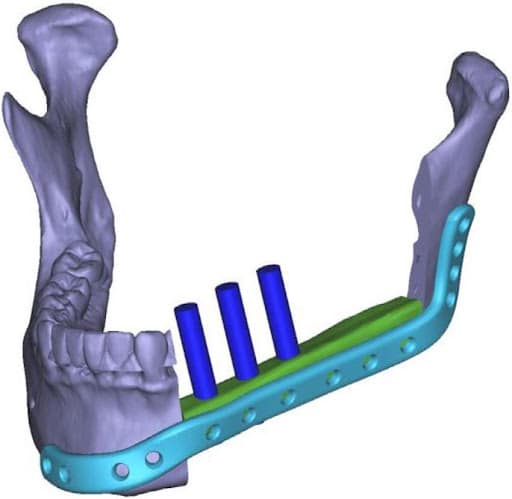
Digital planning for implant placement into graft
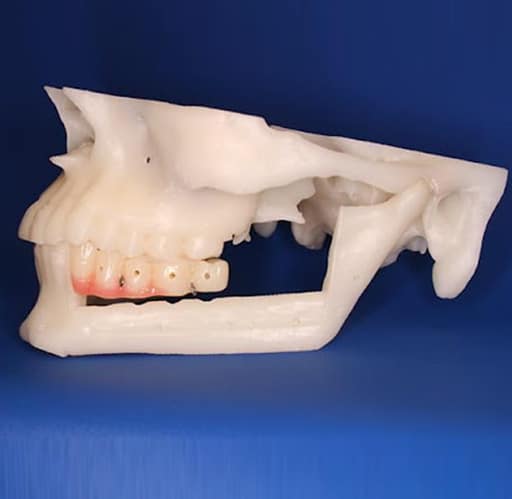
Development of implant retained prosthesis
In essence, patient form and function with personalized jaw reconstruction and dental implant placement can be done in a single-stage procedure!
Dr. Sultan works closely with his plastic surgery colleagues to collaborate in providing this unique service to his patients.
The Single Tooth Implant
Surprisingly, placement and restoration of a single tooth implant can be as challenging and complex with respect to ideal esthetics. Concerns that influence the final result for the replacement of a single tooth are:
- Proper diagnosis.
- Proper planning for implant placement (computer guidance).
- Atraumatic tooth extraction and implant placement.
- Need for additional hard/soft tissue grafting.
- The decision to immediately restore an implant.
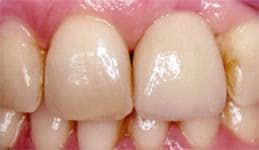
Which tooth is the implant?
Use of Computer Guided Surgery in Implant Surgery
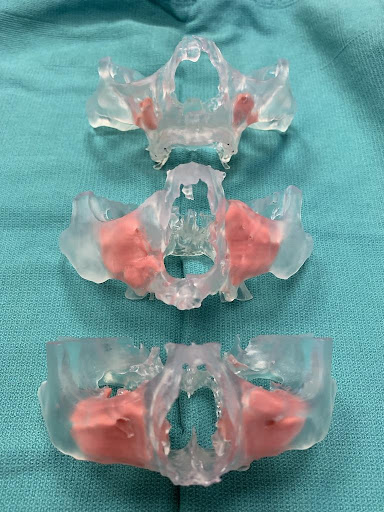
Varying degrees of bone atrophy using 3D models
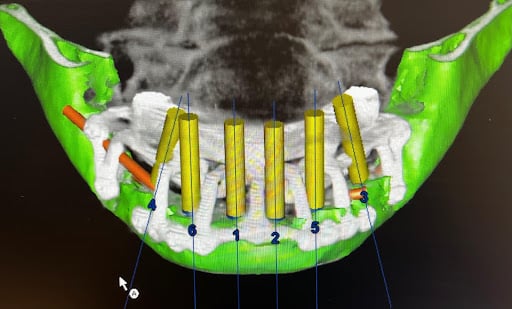
Virtual surgical plan
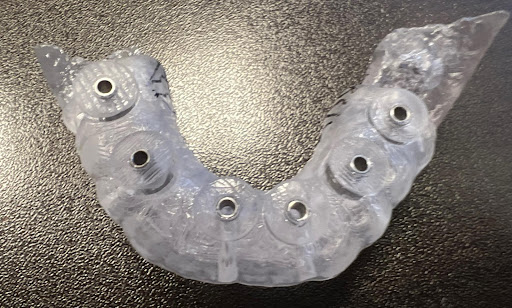
Implant surgical guide
Frequently Asked Questions
How Can I Prepare For My Implant Procedure?
After your consultation and decision to undergo the implant process, you may have very little to do except schedule some time off! Dr. Sultan or a member of our team can discuss the steps that they suggest for you. For example, if you smoke, you may need to quit. You may be prescribed antibiotics to begin taking sometime before your procedure. Other ways to prepare for dental implants include readying your home to be as comfortable a recovery area as possible. You may need to eat soft foods for a short time, so you can begin preparing a healthy, convenient menu. You may also need to avoid taking certain medications and supplements in the weeks before your procedure so you do not face unnecessary bleeding risks. Patients with medical concerns will require clearance by their PCP. Our team is available to answer your questions at any time before your dental implant treatment.
Are Zygomatic Implants Painful?
Getting Zygomatic dental implants is similar to having bone grafting done before receiving dental implants. The discomfort that patients report after each is nearly identical, and, fortunately, not as bad as they had anticipated. In many cases, the soreness that occurs after the dental implant procedure is manageable with over-the-counter medication. As a dental implant specialist who has received considerable training to perform the most advanced techniques, Dr. Sultan is also well-versed in knowing how to manage discomfort. Suggestions can be discussed with you before your implant surgery.
Use of Opiod Sparing Medication Protocol
Dr. Sultan is a firm believer in providing pain control without the need for narcotics. He has developed a novel non-opiod pain management protocol highlighting the use of strong anti-inflammatory and ultra-long-acting anesthetics to control postoperative discomfort for days, rather than hours!
Are There Any Foods Or Drinks I Should Avoid After Receiving Implants?
Yes. Typically, patients who receive dental implants are advised to avoid foods that are hard, crunchy, and sticky. The goal is to allow the implant posts to integrate into the surrounding bone with as little disruption as possible, and chewing is a disruption. While your gums are still healing after the minor surgical procedure, you should avoid hot and spicy foods, as well as those that are acidic, like vinegar. This can help prevent unnecessary irritation.
What Is The Recovery Like?
Even though the zygomatic implants are longer than traditional implants, your recovery from this procedure may be less than you would experience if you had bone grafting to augment the jawbone. While you'll likely need to eat soft foods for at least a few days, studies indicate that zygomatic implants can hold a denture as soon as the day after their placement. This means you may have no more than 24 hours without a natural-looking smile. Dr. Sultan or one of our clinical staff can also discuss with you how you should care for your artificial teeth and gums, which oral care products would be ideal, and more.
**Patients With Zygoma Implants Must Avoid Use Of A Waterpik At All Times !!
During your recovery, you're encouraged to call our office if questions or concerns arise.
Schedule Your Consultation Today!
For more information about ZYGOMA Implants, or to schedule your consultation with Dr. Sultan, call us today at 954.771.8772. Our practice serves Fort Lauderdale and the surrounding areas of Florida.


